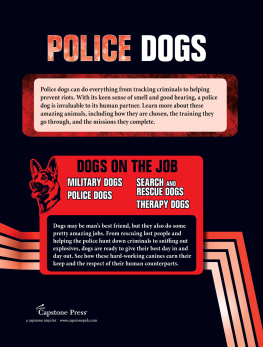Washington, D.C., Police Officer William Gregory and his partner, Dylan, were working their regular midnight shift. Suddenly things took a dangerous turn. A man flagged them down asking for help. He said that another man had just tried to rob him at gunpoint.
Gregory quickly found the and told him to stop. The man chose to run instead. Gregory released Dylan, who raced after the man. The suspect fired his gun at the dog. Dylan fell to the ground, rolled over, and got back up. Dylan kept running after the man who had just shot him.
The suspect shot Dylan two more times before Gregory caught up with him and returned fire. The dog lay on the ground in a pool of blood as the suspect was arrested. But Dylan survived. He was treated at a nearby veterinary hospital and released a few days later.
FACT
Police dogs follow orders, even if it means risking their lives to do so.
The first police dog program was created in Ghent, Belgium, in 1899. The dogs were German shepherds. These dogs had long been for herding cattle and sheep. This work made German shepherds excellent protectors.
Ghent police used dogs to guard important places and control crowds. As guard dogs, they could attack suspects who tried to break into buildings. If a crowd of people became unruly, simply the dogs presence helped prevent a from happening. Most people will back down from a K-9 team more quickly than just a human officer alone.
Soon police departments in other countries developed K-9 programs. The first police dogs were used in the United States in the early 1900s. Police dogs worked in New York City in 1907 and in New Haven, Connecticut, in 1910. Over time the dogs duties expanded. Dogs tracked criminals. They also sniffed out bombs and illegal drugs.
Today hundreds of K-9 programs exist across the United States. German shepherds remain popular breeds for police work, but other breeds do well too. Belgian Malinois, bloodhounds, boxers, Doberman pinschers, and Labrador retrievers are all commonly used in police work.
A Belgian Malinois remains alert beside his handler.
A police officer and his or her K-9 partner often or find stolen property. They may also chase down suspects who try to run away. Police dogs can run faster than people. Even the most athletic criminals are no match for a dog.

Gender Is No Barrier
Most police dogs are male, but female dogs also make great K-9 partners. Deputy Jeff VanHoos and Jaro are a K-9 team from Sangamon County, Illinois. In 2009 Jaro won first place at a U.S. Police Canine Association field trials event. She was the first female dog to earn the honor.
CHAPTER 2
The Best Dog for the Job
To be part of a K-9 police team, a dog must be smart, friendly, and curious. It is also important for a police dog to be . The human officer must be able to count on his or her canine partner to follow commands.
Once a dog has received basic obedience training, it can begin police training. This training usually begins when the dog is about 2 years old. The dogs human partner is usually involved in the training process. It is important that the dog follows its partners commands.
Jobs Police Dogs Can Perform
- article searches
- bomb sniffing
- tracking and trailing suspects
- building searches
- crowd control
- drug sniffing
- evidence searches
- search and rescue
- property and building protection
During training, dogs go with their handlers to . Most police officers rarely fire their weapons. But when police use their guns, their K-9 partners must remain calm. A dog that is scared by gunfire cannot serve as a police dog.
During training a handler teaches a dog to climb over high structures and crawl through small spaces. The dog also learns to jump through open windows. All K-9 officers must learn to track suspects or missing persons. Many police dogs are also taught how to sniff for bombs, drugs, or guns.
About half the dogs that go through training become police dogs. During training it quickly becomes clear when a dog is not right for police work. Dogs that are too shy, too excited, or easily distracted are dropped from the police dog program. Though they may not be right for police work, dogs that fail training usually make wonderful pets.
an officer and canine training on a course
FACT
A police dog can search a vehicle in about three minutes.
One dog that learned very quickly is Chase, a German shepherd from Connecticut. Chase was partnered with Officer Mauro Piroli in North Branford, Connecticut. After Chase joined the police force, his training continued. He was first trained in tracking, officer protection, and building searches. Then he moved on to narcotics training, which lasted about nine weeks.
During narcotics training, Chase and Piroli trained together eight hours a day, five days a week. They learned how to find illegal drugs.
Officer Mauro Piroli and Chase
Training a police dog isnt just time consuming. It is costly. Police departments invest in special equipment for K-9 programs.
For example, Pirolis vehicle is specially designed. The vehicle has a remote system. The system lets Piroli open a door from up to 1,000 feet (305 meters) away. If he is not near the vehicle but needs Chases help, Piroli just presses a button to open the door. Chase can jump out of the vehicle and hurry to help his partner.



























